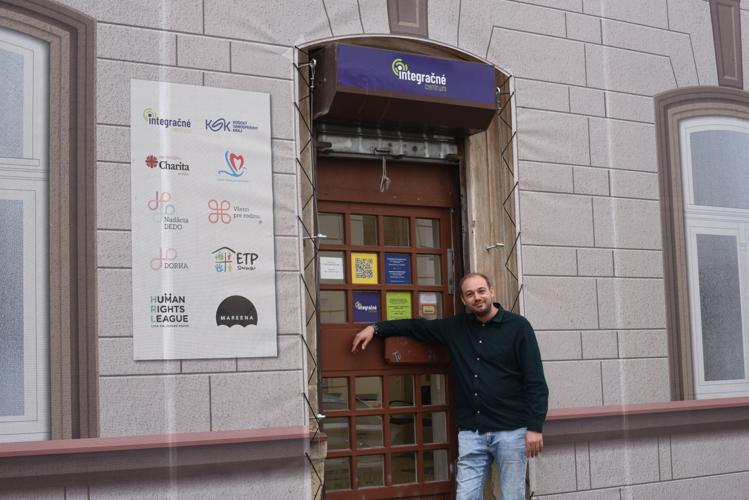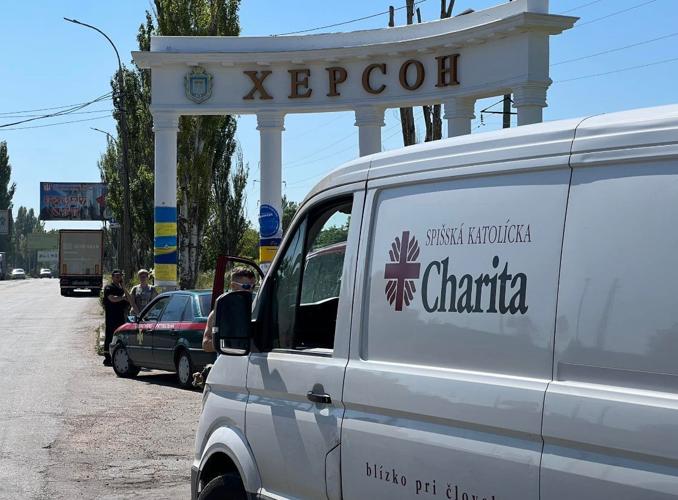Forgotten front: The drive to aid Ukraine
This article is the third in a series of reports on the war in Ukraine’s effect on bordering Eastern European countries. It is written by two Colorado College students traveling through the region and details how local organizations have refocused their efforts to support migrants fleeing the conflict.
KOŠICE, Slovakia • February 24, 2022, began like any other day for Anton Frič. At 6:30 a.m., he ate pancakes with his wife and children. At 7:00 a.m., he switched on the Slovak National Public Radio morning broadcast. That’s when he heard the news.
Russia had invaded Ukraine.
Frič told his boss that he wouldn’t be going to work that morning. Instead, he drove the company van to a storage space in Spič. There, he picked up water, bread, and diapers before driving to the Ukrainian border. That evening, his boss joined him.
Frič works for Caritas, the largest provider of social services in Slovakia. Before the war, they focused on helping impoverished and underprivileged communities inside the country. But like many other humanitarian organizations, their work was redefined by Russia’s invasion.
At the outset, they filed an emergency appeal in search of international assistance. Contributions poured in from other branches of Caritas, private donors, and a dozen foreign countries.
“Due to the support, we managed to open 24 integrational centers that were working all over Slovakia, from the most distant point to Bratislava,” said Alexandra Mruk Papaianopol, manager of the humanitarian and integration department at Caritas Slovakia.
These centers help refugees stay in Slovakia over the long term, providing them with daycare options, psychological support, and legal aid. Even after fifteen months, much of the work is the same as it was at the war’s beginning.
“I’m very surprised to say that even today, what the refugees need most is the humanitarian support. They still come and ask for food or for clothes or for hot meals,” said Mruk Papaianopol. Caritas Spič, the most eastern branch and Frič’s area of operation, currently employs roughly 600 people.
“We are concentrating a lot on supporting Ukraine directly because we know that there are a lot of organizations going there, but not in the war zones,” said Mruk Papaianopol. “Our workers go directly in the war zones.”
That’s what Frič does now. He has taken over 20 trips and spent more than 200 days on the war-torn eastern front where he experiences constant Russian shelling. Now, after returning from his most recent visit to Kherson, Kharkiv, and Dnipro, he has collected several kilos of Russian shrapnel. “I call it ‘souvenirs.’”
Mementos like this are common among aid workers, including 19-year-old Marek Janiga. On his laptop, he has a photo featuring a young girl holding a large stuffed bunny. Behind her, a dud rocket sticks out of the ground just yards from her house.
A Slovak student who has volunteered with Caritas since last July, Janiga was attending high school in Detroit, Mich. when the war broke out. After hearing about his brother and friends helping the relief effort, he moved back home to join them. Now, he attends university classes on Tuesdays and Wednesdays and spends the rest of his week distributing aid near the front lines.
“I was trying a lot of things before, and none of them gave me fulfillment,” said Janiga. “I’ve tried sports, I’ve done music, I’ve done all the academic stuff … nothing really gave me the full perspective of what makes sense in life and I feel like this is something that really can help.”
But while some Slovaks venture into Russian shelling to aid those who stayed in Ukraine, hundreds of thousands of refugees are crossing into Slovakia. Many look for permanent residence beyond Slovakia — Western Europe offers the allure of better wages and higher standards of living.
But according to Joachim Dušan Fraňo, a lawyer with the Human Rights League, roughly two-thirds of the refugees are interested in some form of long-term residence inside Slovakia. Many others wait for the war’s end to return home. Košice, situated only 56 miles from the border, provides both proximity to Ukraine and the benefits of an urban job market.
Dušan Fraňo’s busy office in downtown Košice also reflects some of the refugee need for civil services. He is the only full-time attorney at the HRL’s small branch in eastern Slovakia. To date, he has helped roughly 750 refugees with legal counsel, operating from his publicly funded office space. He works alongside four or five others, each providing different forms of civil assistance.
Although closer to the conflict, the center in Košice is vastly smaller than the one in the nation’s western capital. The eastern office can help up to 30 refugees a day; the Bratislava center is capable of processing up to 1,000.
As a result, the Bratislava center is designed for mass capacity use. The facility, a former city bus station, offers multiple services for refugees. At the check-in point, they can pick up boxes of humanitarian aid supplied by Caritas. Upstairs, they can apply for temporary residence with the foreign police. In contrast to Košice’s one full-time attorney, Bratislava keeps over a dozen HRL lawyers on staff. The capital center also houses a medical facility, a childcare center, and a makeshift theater space.
Košice’s understaffing is not an error of planning. The politics of the region are less welcoming to refugees than in the nation’s capital.
The city’s University Hospital closed down its Ukrainian Care Center on June 30, despite a continued demonstrated need for the service. While Ukrainians are still able to visit urgent care centers in the city, they no longer have access to dedicated preemptive care.
When the HRL tried to communicate the issue to the city, officials said that they would pass the complaint along to the state and wait for the national government’s response.
“Nobody is interested for them,” said Dušan Fraňo. “This is the problem, this is the reality of Košice.”
According to the lawyer, Ukrainians in Košice sometimes face double standards from law enforcement. Cars with Ukrainian license plates are more likely to be ticketed than those with Slovak plates. Rules for public transport are written in Slovak, and the city has been slow to publish a Ukrainian version, even after the HRL provided a translated copy.
These local issues hint at broader trends across the country. According to GLOBESEC, a nonpartisan, nongovernmental organization based out of Bratislava, 17% of Slovakians believe Ukraine is most responsible for the war. Another 34% blame the West.
But Slovaks with a desire to help are undeterred and continue operating throughout the region, from Bratislava to Košice to Kherson.
Frič pays little mind to the internal opposition. After a year and a half, he knows which border checkpoints post pro-Russia guards who will turn him away. He is not interested in geopolitics, he just wants to get to those in need.
“It’s important for those people to know that we are willing to spend time with them, that we traveled 2,000 kilometers to help them, and we are there for them.”






